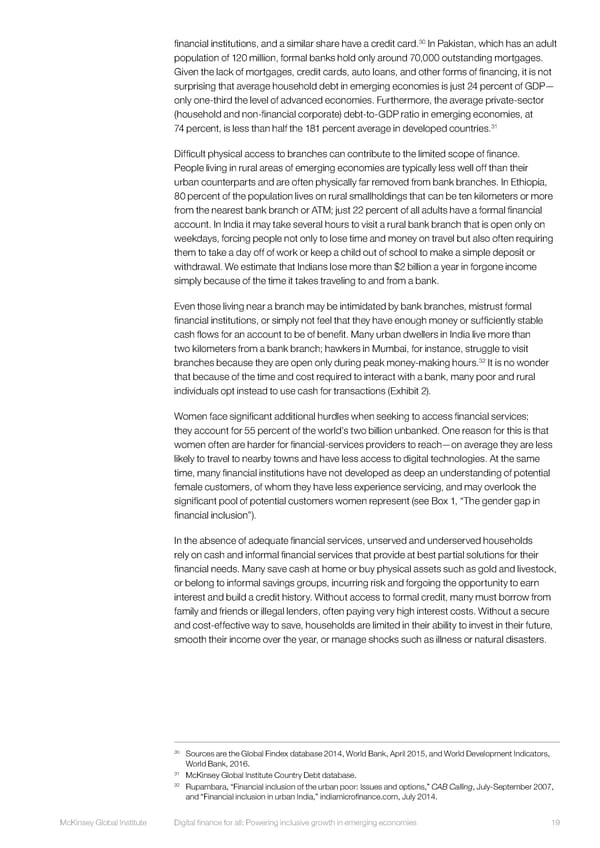30 financial institutions, and a similar share have a credit card. In Pakistan, which has an adult population of 120 million, formal banks hold only around 70,000 outstanding mortgages. Given the lack of mortgages, credit cards, auto loans, and other forms of financing, it is not surprising that average household debt in emerging economies is just 24 percent of GDP— only one-third the level of advanced economies. Furthermore, the average private-sector (household and non-financial corporate) debt-to-GDP ratio in emerging economies, at 74 percent, is less than half the 181 percent average in developed countries.31 Difficult physical access to branches can contribute to the limited scope of finance. People living in rural areas of emerging economies are typically less well off than their urban counterparts and are often physically far removed from bank branches. In Ethiopia, 80 percent of the population lives on rural smallholdings that can be ten kilometers or more from the nearest bank branch or ATM; just 22 percent of all adults have a formal financial account. In India it may take several hours to visit a rural bank branch that is open only on weekdays, forcing people not only to lose time and money on travel but also often requiring them to take a day off of work or keep a child out of school to make a simple deposit or withdrawal. We estimate that Indians lose more than $2 billion a year in forgone income simply because of the time it takes traveling to and from a bank. Even those living near a branch may be intimidated by bank branches, mistrust formal financial institutions, or simply not feel that they have enough money or sufficiently stable cash flows for an account to be of benefit. Many urban dwellers in India live more than two kilometers from a bank branch; hawkers in Mumbai, for instance, struggle to visit 32 branches because they are open only during peak money-making hours. It is no wonder that because of the time and cost required to interact with a bank, many poor and rural individuals opt instead to use cash for transactions (Exhibit 2). Women face significant additional hurdles when seeking to access financial services; they account for 55 percent of the world’s two billion unbanked. One reason for this is that women often are harder for financial-services providers to reach—on average they are less likely to travel to nearby towns and have less access to digital technologies. At the same time, many financial institutions have not developed as deep an understanding of potential female customers, of whom they have less experience servicing, and may overlook the significant pool of potential customers women represent (see Box 1, “The gender gap in financial inclusion”). In the absence of adequate financial services, unserved and underserved households rely on cash and informal financial services that provide at best partial solutions for their financial needs. Many save cash at home or buy physical assets such as gold and livestock, or belong to informal savings groups, incurring risk and forgoing the opportunity to earn interest and build a credit history. Without access to formal credit, many must borrow from family and friends or illegal lenders, often paying very high interest costs. Without a secure and cost-effective way to save, households are limited in their ability to invest in their future, smooth their income over the year, or manage shocks such as illness or natural disasters. 30 Sources are the Global Findex database 2014, World Bank, April 2015, and World Development Indicators, World Bank, 2016. 31 McKinsey Global Institute Country Debt database. 32 Rupambara, “Financial inclusion of the urban poor: Issues and options,” CAB Calling, July-September 2007, and “Financial inclusion in urban India,” indiamicrofinance.com, July 2014. McKinsey Global Institute Digital finance for all: Powering inclusive growth in emerging economies 19
 DIGITAL FINANCE FOR ALL Page 30 Page 32
DIGITAL FINANCE FOR ALL Page 30 Page 32